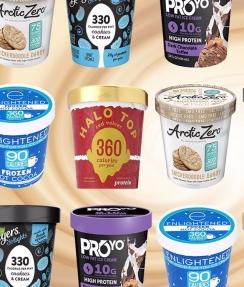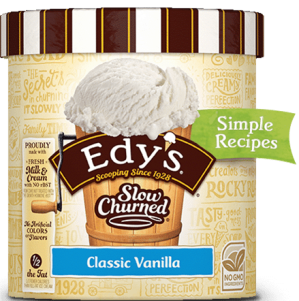Halo Top. Enlightened. Breyer’s Delights. Skinny Cow. Arctic Zero. Chances are that if you frequently visit the ice cream aisle in your grocery store, you’ve probably seen these products on the shelf. Most of these ice creams have a very low calorie content (usually around 280 calories for a full pint), and they all claim to be a “better-for-you ice cream”. And with today’s society being so focused on diet, it’s no wonder that people are ditching real ice cream for these “healthier” options.

Personally, I find it odd that people avoid ice cream because it’s a “bad” food, but then all the sudden a product marketed as “healthy ice cream” comes out, and people are all over it. Not only that, but most people won’t even eat a bowl of regular ice cream… yet they eat a whole pintof “low-calorie” ice cream. How does that make any sense? As soon as people hear the word “healthy”, they automatically assume that it’s good-for-you. After all… it’s low in calories, so you don’t have to feel guilty about eating it, right? However, that is not always the case! Let’s take a look at some low-calorie ice creams and compare them to regular ice cream to see how they compare.
Low-Calorie Option #1: Halo Top

Ingredients: (Vanilla Bean flavor)
Milk and cream, eggs, erythritol, prebiotic fiber, milk protein concentrate, organic cane sugar, vegetable glycerin, vanilla extract, vanilla beans, sea salt, organic carob gum, organic guar gum, organic stevia.
Erythritol:
Let’s start with erythritol, which is a sugar alcohol. In one pint of Halo Top Vanilla Bean ice cream, there are a whopping 20 grams of sugar alcohols! For those of you that don’t know, sugar alcohols like erythritol are absorbed into the bloodstream more slowly than white sugar. That means they don’t raise blood sugar levels as much as white sugar, which is definitely a good thing. However, erythritol has serious side effects and can easily cause gas, bloating, and diarrhea. So was that “ice cream” loaded in sugar alcohols really worth all the gas and bloating you’ll probably feel afterwards? In my opinion, no.
Prebiotic Fiber:
Not only are these pints high in sugar alcohols, but they’re also high in fiber as well. One pint of this stuff can give you 12 grams of fiber, which is already about half of what you should be getting in one day. The key to fiber is to spread it out throughout the day – not to eat it all at once. Otherwise, you’re going to feel bloated and constipated, which is not something we want. Instead of getting “prebiotic fiber” found in low-calorie ice cream, try getting fiber from NATURAL FOODS – fruits, vegetables, or whole grains. This fiber is much easier for the body to absorb and digest, and the best part? It’s a REAL food, not a synthetic, man-made product.
Nutrition Facts:
Now let’s take a look at the nutrition details for that same pint of Halo Top. Since it’s advertised as “240 calories for the whole pint”, most people aren’t going to stop at just one spoonful; most people are going to eat the whole thing. And here’s what you get from doing that:
- 240 calories
- 8 grams of fat
- 440 mg sodium
- 20 g sugar
- 20 grams sugar alcohols
- 20 grams protein
- 12 grams fiber
Low-Calorie Option #2: Arctic Zero:

Ingredients (Maple Vanilla flavor):
Purified water, whey protein concentrate (milk), organic cane sugar, chicory root, sugarcane fiber, guar gum, xantham gum, natural flavors, organic vanilla, sea salt, monk fruit concentrate.
Nutrition Facts:
If you eat a full pint, you’ll get:
- 150 calories
- 0 fat
- 320 mg sodium
- 8 g fiber
- 20 grams sugar
- 12 grams protein
Conclusion:
Doesn’t seem too bad, right? You can eat a full pint of each of those and still not consume many calories. But think about it: what are you eating if you’re not eating calories? There are a ton of added ingredients in those products, and personally, I like to eat foods with a short ingredient list.
Also, look at the ingredients again. For Arctic Zero, the first ingredient is WATER. WATER! It shouldn’t even be considered “ice cream”! In fact, there is absolutely no fat at all, which means it’s not technically even considered ice cream! Would you rather eat a whole pint of Halo Top or Arctic Zero and not enjoy it as much, or would you rather treat yourself to a bowl of REAL, creamy ice cream? The choice is up to you.
Lastly, you shouldn’t purchase these ice creams simply because they claim to be high in protein. Since ice cream naturally isn’t high in protein, it’s safe to assume that the protein they add to these low-calorie ice creams is not naturally occurring and comes from a synthetic source. Therefore, you’re much better off getting protein from whole foods like meats, eggs, or beans.
The Real Stuff: Ice Cream
Next, let’s take a look at brands of real ice creams and see how the nutrition stats line up with low-calorie ice creams. But before we go into details, I just want to give you a background on ice cream. In order to be classifed as ice cream, the FDA mandates that the product must:
- Contain at least 10% milkfat,
- Have no more than 100% overrun (the amount of air whipped into it), and
- Weigh no less than 4.5 lbs. per gallon
Therefore, that Arctic Zero being marketed as “healthy ice cream”? Yeah…. it’s not even considered real ice cream. There’s just no comparison to that and regular ice cream. Let’s face it. Nothing will ever beat the smooth, creaminess of good old ice cream!
REAL Ice Cream #1: Edy’s Slow-Churned Vanilla

Ingredients:
Non-fat milk, cane sugar, cream, buttermilk, tapioca starch, pectin, guar gum, natural flavor.
Simple, yet real ingredients. No artificial sugar alcohols or crazy fibers or anything like that.
Nutrition Facts:
If you eat 1/2 cup of ice cream, you’ll get:
- 100 calories
- 3 g fat
- 30 mg sodium
- 13 g sugar
- 3 g protein
- 0 g fiber
REAL Ice Cream #2: Breyer’s Natural Vanilla

Ingredients:
Milk, sugar, vegetable gum, natural flavors
Nutrition Facts:
Per 1/2 cup serving:
- 130 calories
- 7 g fat
- 35 mg sodium
- 14 g sugar
- 2 g protein
The Takeaway:
As you can see, Halo Top or Arctic Zero probably seem like the better option when you want some ice cream: after all, they’re lower in calories and contain less sugar.. therefore they must be better for you, right? Wrong. It’s important to remember that it’s not as simple as “low calorie is better”. Just remember, when something is low-calorie, something is often added to make up for those lack of calories. And in this case, artificial ingredients, sugar alcohols, and synthetic fibers are all added. Therefore, it’s much better to stick to the all-natural REAL ice cream, even if it may be a little higher in sugar or fat!
A Dietitian’s Argument Against Low-Calorie “Ice Creams”:
Here’s the thing: as a dietitian, I preach to people the importance of eating a balanced diet. This means eating fruits and vegetables, but it also means listening to your body and eating a bowl of ice cream or some chips when you are craving it. One of the key words I use in my daily life is moderation. All things are good in moderation. But is eating a whole pint of ice cream teaching you to enjoy foods in moderation? No. Rather, it’s teaching you that it’s okay to eat a full pint of ice cream every night “just because it fits into your calories”. Personally, I would much rather have just one bowl of the richest, creamiest ice cream, as opposed to eating a sub-par “ice cream” just because it’s healthy. Not only will this satisfy my craving for the food, but it helps reinforce the idea that all foods should be eaten in moderation – you shouldn’t go overboard on one certain food.
Another thing I dislike about these low-calorie ice creams is that they are considered “guilt-free” or marketed as “healthier options” than regular ice cream. This gives consumers the impression that they should feel guilty for eating regular ice cream because it’s “unhealthy”. This message that many companies are portraying is entirely wrong – people should NEVER feel guilty about eating ice cream, or any food for that matter. By labeling foods as “good” or “bad”, we have this mindset that we are bad people if we eat a so-called “bad” food. However this is NOT the case. All foods are good and provide us with fuel we need, so we should never feel bad about eating a certain food. Likewise, we should never avoid a food because it’s “bad” (and then make up for it by over-indulging on lower-calorie or healthier versions of that food).
Next time you’re in the grocery store shopping for a carton of ice cream, do yourself a favor and buy the one that really SOUNDS good to you, not the one that looks the healthiest. If you find that you truly enjoy the flavor and texture of Halo Top, then by all means, go for it and buy that one! But if you’re craving a true, creamy ice cream, buy it, and DO NOT feel guilty about enjoying it. Remember: all foods are good foods, as long as we eat them in moderation 🙂












